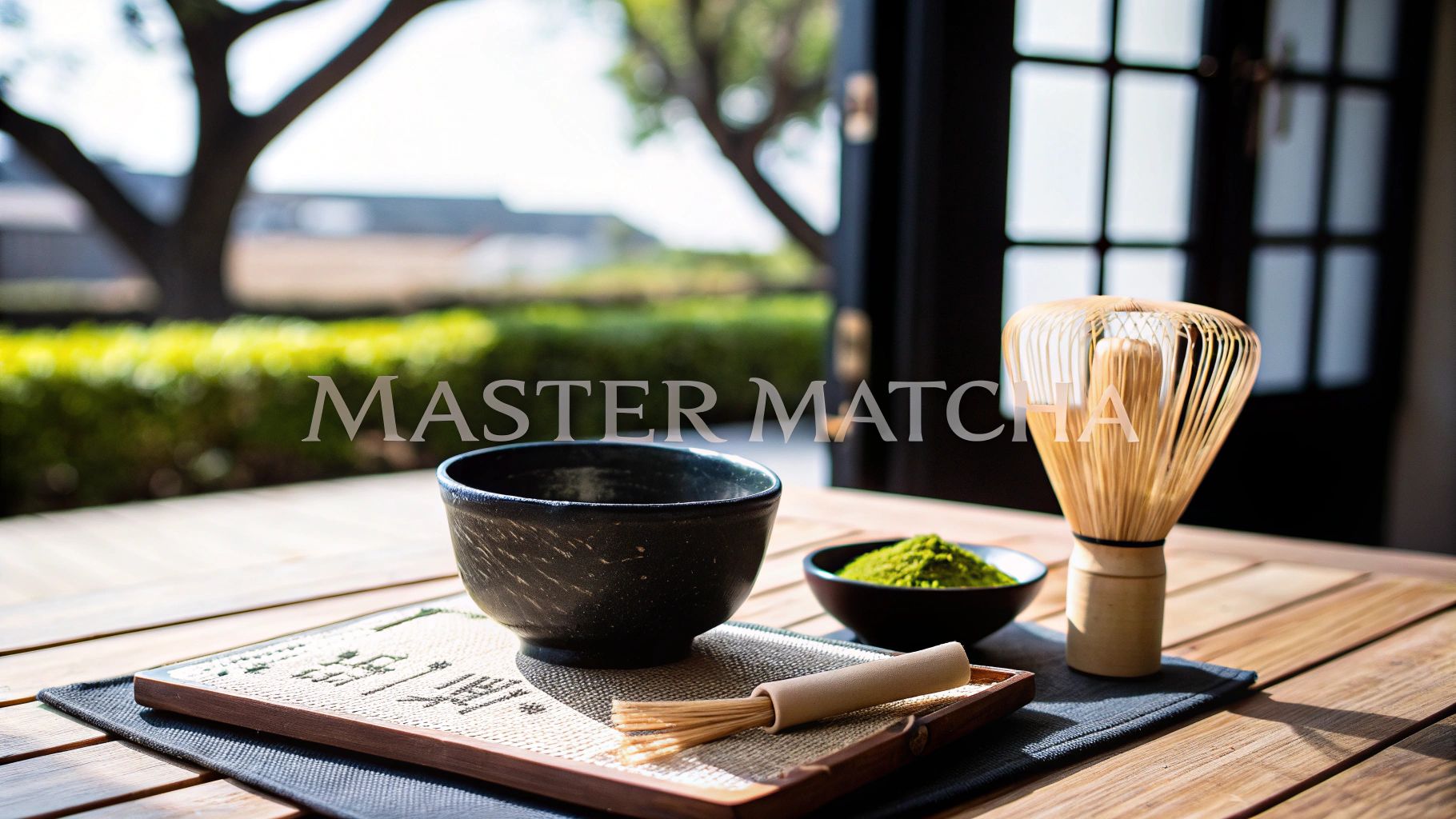Learning how to prepare matcha tea is wonderfully simple. At its heart, it's just three steps: sift the powder, add hot but not boiling water, and whisk it into a frothy tea. Once you master these, you'll see how easy it is to transform that fine green powder into a vibrant, calming drink. This isn't some complex ritual—it's an achievable and rewarding part of your daily routine.
Your First Perfect Bowl of Matcha
Let's get one thing straight: you don't need to be a tea master to make a fantastic bowl of matcha. We're going to make a great one right now by focusing on the three things that really count for that first success: sifting the powder properly, getting the water temperature just right, and using the correct whisking motion.
Think of this as your first win. By nailing these fundamentals, you’ll unlock a smooth, flavourful, and beautifully frothy bowl of matcha. While starting with high-quality powder like our Amatsu Pure certainly sets you up for exceptional taste, it's your technique that brings out its full potential.
The Core Steps to Success
The journey from powder to a perfect cup is much shorter than you might imagine. It’s less about owning every traditional tool from the start and more about understanding a few key principles.
- Sifting Your Powder: Honestly, don't skip this. Running your matcha through a fine-mesh strainer is crucial for breaking up the tiny clumps that naturally form from static. This one small action is the secret to a silky-smooth tea, free from any unpleasant grit.
- Water Temperature: This is a big one. Never, ever use boiling water. Anything above 80°C will scald the delicate tea leaves, leaving you with a bitter, harsh flavour. Just be patient and let your kettle sit for a minute or two after it boils.
- The Whisking Motion: The magic is in the whisk. A quick, energetic zig-zag or 'W' motion is what you're after. This whips air into the tea, releasing its complex umami flavour and creating that signature creamy foam on top.
This traditional method remains the most popular way to enjoy matcha for a reason. In the UK, powdered matcha dominates the market, holding a revenue share of around 55.02%, which shows just how much people value this authentic preparation. You can dive deeper into these market trends over at Grandview Research.
For a quick reference, here’s a simple breakdown of what to focus on.
Quick Guide to Perfect Matcha Preparation
This table summarises the essentials for preparing a traditional, delicious bowl of matcha tea.
| Component | Why It Matters | Quick Tip |
|---|---|---|
| Sifting | Prevents clumps and ensures a silky-smooth texture. | Use a fine-mesh tea strainer and gently push the powder through with your scoop. |
| Water Temperature | Protects the delicate flavour from bitterness. | Let a boiled kettle cool for 2-3 minutes to reach the ideal 70-80°C range. |
| Whisking Technique | Creates the signature froth and aerates the tea. | Use a rapid 'W' or 'M' motion with your wrist, not your whole arm. |
Getting these three elements right is the foundation of a great matcha experience.
The real reward of preparing matcha is the mindful pause it creates in your day. Taking a few moments to sift, pour, and whisk connects you to a centuries-old tradition and sets a calm, focused tone.
Ultimately, making matcha is a personal ritual. Once you feel comfortable with the basics, feel free to play with the powder-to-water ratio to find the strength and consistency you love most. For more in-depth instructions and extra tips, you might find our complete guide on how to make matcha helpful.
Gathering Your Authentic Matcha Toolkit
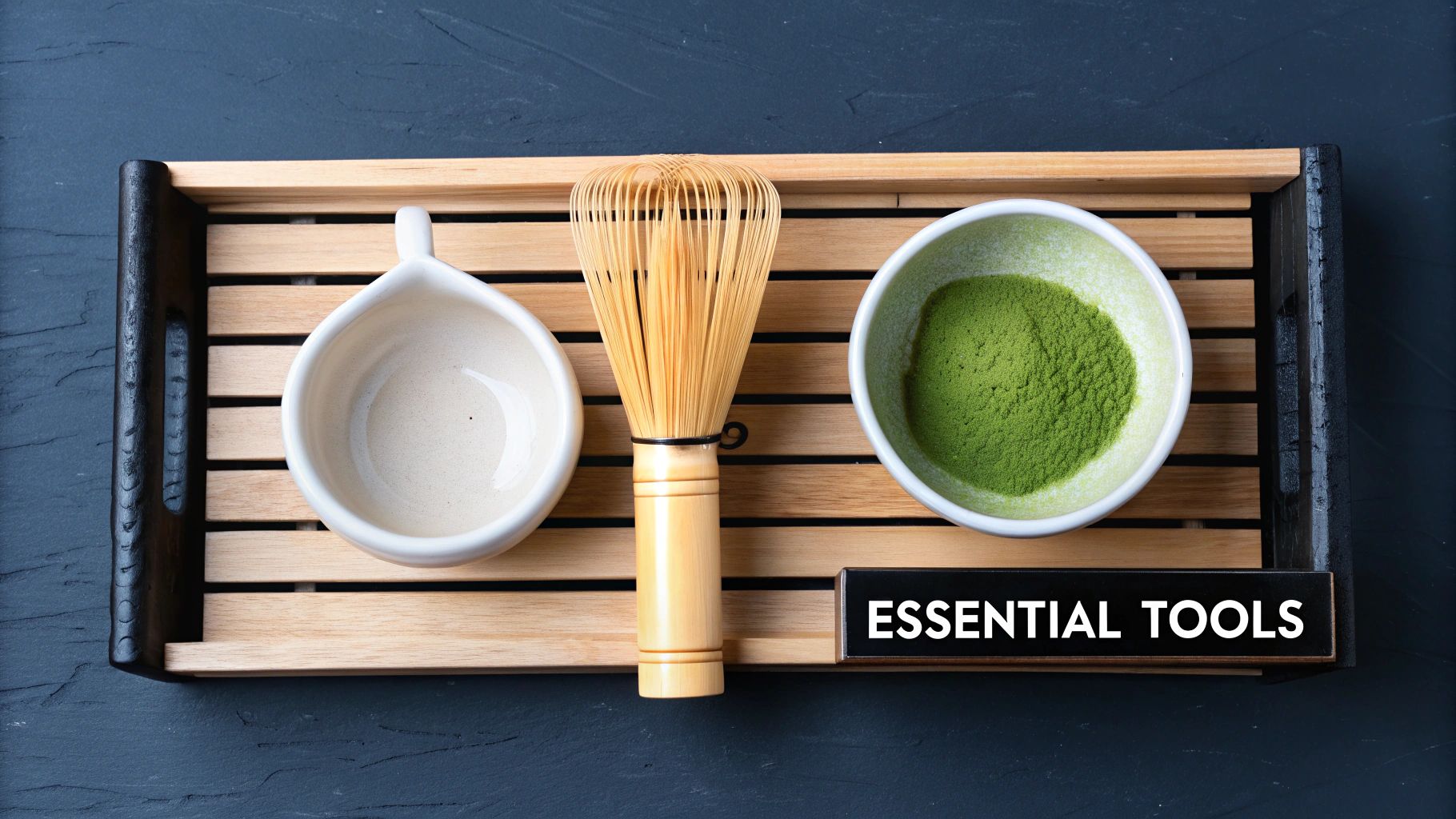
Learning to prepare matcha properly is as much about the tools you use as it is about the technique. Of course, you can get started with a simple mug and spoon, but embracing the traditional toolkit turns making a drink into a mindful, rewarding ritual. Each tool has a specific purpose, and they all work together to create that perfect texture and flavour.
This isn't about being overly strict for tradition's sake. It's about understanding why these simple, elegant utensils have been the go-to for centuries. They are proven to produce a far superior cup of tea, something a standard metal spoon just can't replicate.
At the heart of any authentic matcha preparation is a set of three core items. These aren't just for show; they are functional instruments that directly impact the quality of your final bowl.
The Essential Trio
If you truly want to elevate your experience, consider getting these three key pieces. They form the foundation of the Japanese tea ceremony and are essential for anyone serious about making excellent matcha at home.
- The Chasen (Bamboo Whisk): This is your most critical tool. A proper chasen usually has over 100 flexible prongs, all carved from a single piece of bamboo. These delicate tines are uniquely designed to suspend the matcha powder evenly in water and whip air into the mixture, creating that signature creamy microfoam. A metal whisk is too harsh, and a spoon just stirs things around, leaving you with clumps.
- The Chawan (Matcha Bowl): A chawan is much more than just a bowl. Its wide, flat bottom and high sides are specifically shaped to give you plenty of room to whisk properly. This design allows the chasen to move freely in that crucial 'W' or 'M' motion, ensuring all the powder gets incorporated without splashing tea everywhere.
- The Chashaku (Bamboo Scoop): This simple, elegant scoop is crafted to measure the perfect amount of matcha powder. One to two scoops (about half a teaspoon) is the standard dose for a traditional bowl of usucha (thin tea), which helps you get consistent results every single time.
Practical Alternatives and Why Tradition Wins
If you're just starting and not quite ready to invest, there are other options. An electric milk frother is probably the next best thing to a chasen. It can whip up a decent froth, although it might not break down clumps quite as well. In a real pinch, you could even try shaking the powder and water vigorously in a sealed jar.
However, there's a reason the traditional method has stood the test of time.
Using a chasen and chawan is not merely about tradition; it’s about control. The tactile feedback from the bamboo whisk lets you feel when the tea is perfectly smooth, creating a connection to the process that modern gadgets simply cannot offer.
Investing in a proper toolkit transforms your preparation from a chore into a practice. It honours the incredible craft behind high-quality tea like Amatsu Pure and ensures every bowl you make has the vibrant colour, rich umami flavour, and silky froth it deserves. It really is the key to unlocking the full potential of your powder.
Mastering the Art of Whisking
The real magic of making exceptional matcha happens with the whisk. While having the right tools and getting the water temperature spot-on sets the stage, it's the whisking that truly brings the tea to life. This motion aerates the tea, unlocks that deep, savoury umami flavour, and creates the signature layer of creamy microfoam. Simply stirring it around won't cut it; the goal is to suspend the fine powder perfectly in the water, not just mix it in.
It’s about technique, not brute force. You need finesse, using your wrist to do the work rather than your entire arm. This control is what separates a gritty, underwhelming drink from a smooth, frothy, café-quality bowl of matcha.
This quick visual guide highlights the essential steps to take before you even start whisking. Getting these right is the key to a clump-free texture.
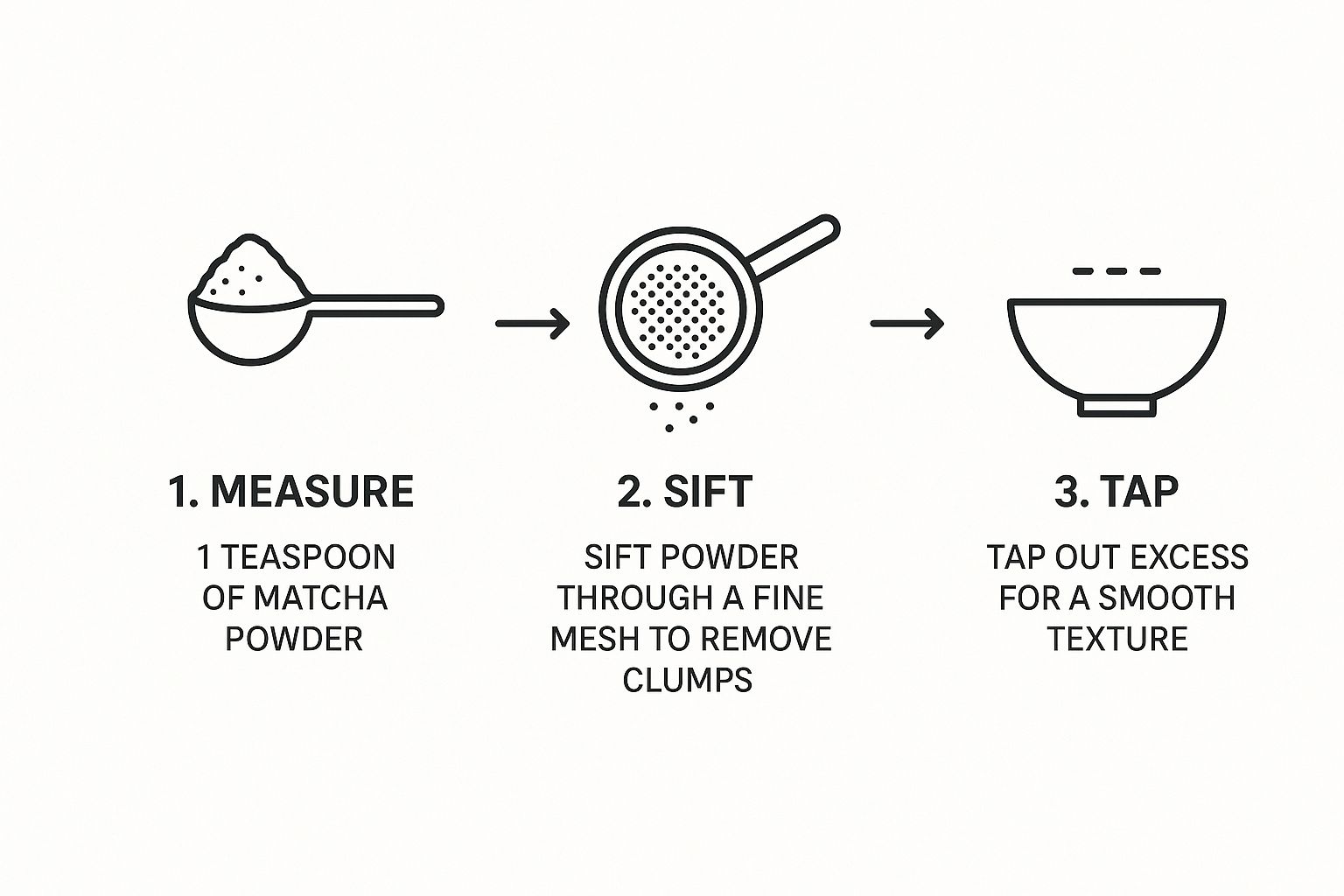
As you can see, measuring and sifting are non-negotiable for a perfect bowl. This simple preparation makes the powder light and lump-free, which makes it infinitely easier to get a silky consistency once you add the water.
The Zig-Zag Whisking Motion
First things first: forget stirring in circles. The secret to beautifully prepared matcha lies in a rapid zig-zag or ‘W’ motion. This is how you create that lovely, uniform froth and avoid the large, soapy bubbles that often come from a lazy circular stir.
To begin, hold your chasen (the bamboo whisk) lightly but firmly. Dip the tines into the matcha and water, and then, using just your wrist, start whisking back and forth with real energy.
- Movement: Picture yourself drawing a capital 'W' or 'M' back and forth across the bottom of the bowl.
- Speed: The motion needs to be fast and energetic. You’re whipping air into the liquid, and that requires some pace.
- Duration: Keep this up for about 20-30 seconds. You’ll actually feel the resistance change as the tea thickens and a fine foam starts to build on the surface.
Once you get the hang of it, you’ll find a natural rhythm. The sound of the whisk against the bowl will become a familiar, almost meditative part of your matcha ritual. For a more detailed breakdown of getting your form just right, have a look at our guide on how to whisk matcha.
Troubleshooting Common Whisking Problems
Even with the correct motion, you might run into a few snags. Don't worry, a few small tweaks to your technique can make all the difference.
Key Insight: A flat, lifeless tea is usually because you haven't whisked vigorously or long enough. On the other hand, a gritty texture almost always means you skipped the crucial sifting step before adding water.
Here’s a quick guide to fixing the most common issues:
- Gritty or Lumpy Tea: Nine times out of ten, this means the matcha wasn't sifted. Always, always pass your powder through a fine-mesh sieve to break up any clumps before you add water. It’s the single most effective thing you can do for a smooth texture.
- No Froth or Foam: If your matcha is looking a bit flat, you need to pick up the pace. Make sure your wrist is doing all the work in a quick, snappy motion. It's also worth checking you're using enough matcha powder for the amount of water.
- Large, Soapy Bubbles: This is a classic sign of stirring in circles. Stick to that energetic zig-zag motion to create a delicate microfoam. To pop any remaining large bubbles at the end, gently lift the whisk out from the centre of the bowl—this helps the foam settle beautifully.
The Importance of Water Temperature
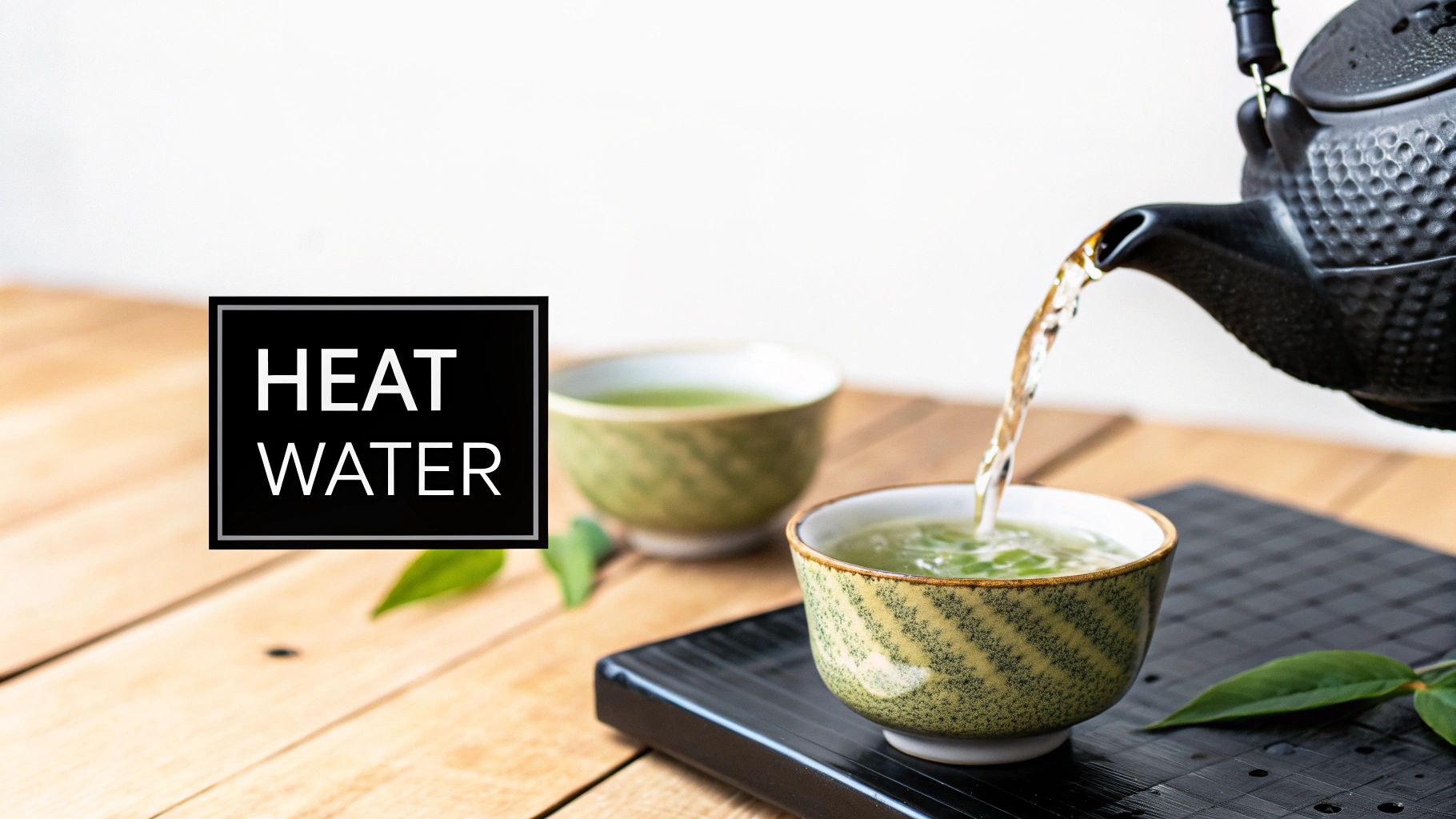
If there's one mistake that can single-handedly ruin even the finest matcha, it's getting the water temperature wrong. We've all been there: clicking the kettle on, waiting for the boil, and pouring it straight over the delicate green powder. The result is always the same—a bitter, astringent, and frankly unpleasant brew.
This happens because matcha powder is ground from incredibly delicate, young tea leaves. When you hit them with boiling water, you're essentially scalding them. This scorching action burns the leaves, releasing a flood of tannins, which are the culprits behind that harsh, bitter flavour we’re trying to avoid.
The goal is to coax out the good stuff—the subtle sweetness and that sought-after umami character that makes ceremonial-grade matcha so special. Getting the temperature right isn't just a suggestion; it's a critical part of the entire ritual.
Finding the Sweet Spot for Temperature
The ideal temperature for making matcha is somewhere between 70–80°C (160–175°F). This is the magic window where the tea’s complex flavours are gently unlocked without releasing any bitterness. Water in this range dissolves the powder perfectly, helps create a beautiful froth, and ensures a smooth, mellow taste.
But what if you don't have a fancy temperature-controlled kettle? Don't worry, it's much simpler than you think to get it right.
- The Wait-and-Pour Method: This is our go-to technique. Just boil your water, then let the kettle sit with the lid open for 2-4 minutes. This short cooling period is almost always enough to bring the temperature down into that perfect zone.
- The Transfer Method: Another easy trick is to pour the boiling water into a different vessel first. A good rule of thumb we've learned is that each transfer—from the kettle to a jug, for instance—drops the temperature by about 5-10°C.
The patience you practice in waiting for your water to cool is directly rewarded in the flavour of your tea. Rushing this step is the fastest way to a bitter brew, no matter how exquisite your Amatsu Matcha powder is.
Why the Quality of Your Water Matters
Beyond just temperature, the actual water you use makes a surprising difference. Think of it like a canvas for a painting; a clean, neutral base allows the true colours—or in this case, flavours—to shine through.
Tap water, especially in the hard-water areas common across the UK, is often full of minerals and chemicals like chlorine that can interfere with matcha’s delicate notes. These impurities can muddy the taste, masking the subtle sweetness and vibrant grassy notes you’re meant to enjoy.
For the best results, we always recommend using filtered water. A simple filter jug is all you need to strip away those unwanted extras. This provides a clean slate, allowing the rich flavour of your Amatsu Pure matcha to take centre stage and giving you the full experience, from its sweet start to its smooth, umami finish.
Creative Recipes Beyond the Bowl
Once you've got the hang of whisking a traditional bowl of matcha, you’ll find a whole world of culinary creativity waiting for you. This is where the fun really begins. Moving beyond the classic tea lets you weave matcha's unique flavour and wellness benefits into almost any part of your day, from a morning latte to a post-workout smoothie.
Matcha's versatility is one of its greatest strengths. It's so much more than a drink for a quiet moment; it’s a powerful ingredient that can elevate your daily routines. With a few simple tweaks, you can whip up matcha-based creations that perfectly suit your lifestyle.
The Creamy Matcha Latte: Hot or Iced
The matcha latte has become a modern classic for a reason. It's creamy, comforting, and wonderfully customisable. The secret to a perfect latte is to start by making a concentrated matcha shot, just as you would for traditional tea, before adding your milk.
- For a Hot Latte: Start with 1-2 tsp of matcha powder and about 60ml of hot (but not boiling) water. Whisk it until it's perfectly smooth and frothy. Next, heat and froth 180ml of your preferred milk—oat and almond milk are fantastic choices—and gently pour it over your matcha shot.
- For an Iced Latte: Prepare your matcha shot using the same method. Then, simply fill a glass with ice, pour in your cold milk, and top it off with the freshly whisked matcha. A quick stir and it's ready to sip.
This is a great place to experiment with our functional blends. For a latte that sharpens your focus, try Amatsu Shrooms. Or for a daily ritual that promotes luminous skin from within, our collagen-infused Amatsu Radiance is the perfect choice.
Nutrient-Dense Matcha Smoothies
Adding a spoonful of matcha to your smoothie is one of the easiest ways to pack in extra nutrients and a clean energy lift. Its earthy notes pair beautifully with fruits, leafy greens, and healthy fats, making it a brilliant addition to your breakfast or pre-workout fuel.
A common pitfall is just tossing the matcha powder straight into the blender with everything else, which often leads to clumps. To guarantee a silky-smooth texture, always whisk your matcha into a paste with a little bit of liquid (like water or milk) before you add it to the rest of your smoothie ingredients.
If you’re looking for a powerful pre-workout drink, Amatsu Strength is the perfect base, as it’s already infused with creatine to support muscle performance and recovery. Try blending it with a banana, a handful of spinach, a scoop of protein powder, and some almond milk for a truly functional boost. For more ideas, check out our guide on the different ways to use matcha powder.
The growing popularity of these creative recipes is no surprise. The UK matcha tea market is currently valued at around 137.25 million USD and is set to grow even more. This surge is really driven by a greater appreciation for matcha's health benefits and the demand for innovative, delicious ways to enjoy it. You can explore the complete analysis on the growing UK matcha market at Market Research Future.
Amatsu Matcha Product Guide for Recipes
With all the creative possibilities, you might be wondering which of our matcha blends is the right one for your next recipe. We’ve put together this simple guide to help you choose the perfect powder for whatever you're making, whether it's a simple latte or something more adventurous.
| Amatsu Product | Best Used For | Preparation Tip |
|---|---|---|
| Amatsu Pure | Traditional teas, lattes, and premium desserts where a smooth, refined flavour is key. | Whisk with 80°C water for the best flavour profile. Perfect for impressing guests. |
| Amatsu Strength | Pre-workout smoothies and energy-boosting drinks. | Blend with fruits like banana or mango to complement the creatine-infused formula. |
| Amatsu Shrooms | Morning lattes, focus-enhancing teas, and wellness shots. | Pairs beautifully with oat milk to create a creamy, brain-boosting start to your day. |
| Amatsu Radiance | Beauty lattes, skin-loving smoothies, and daily wellness drinks. | Mix into a warm latte or blend into a berry smoothie to support your inner glow. |
This table should give you a great starting point for incorporating our different blends into your daily routine. Don't be afraid to experiment—the best recipe is the one you love the most. Happy creating!
Why Sourcing Quality Matcha Matters
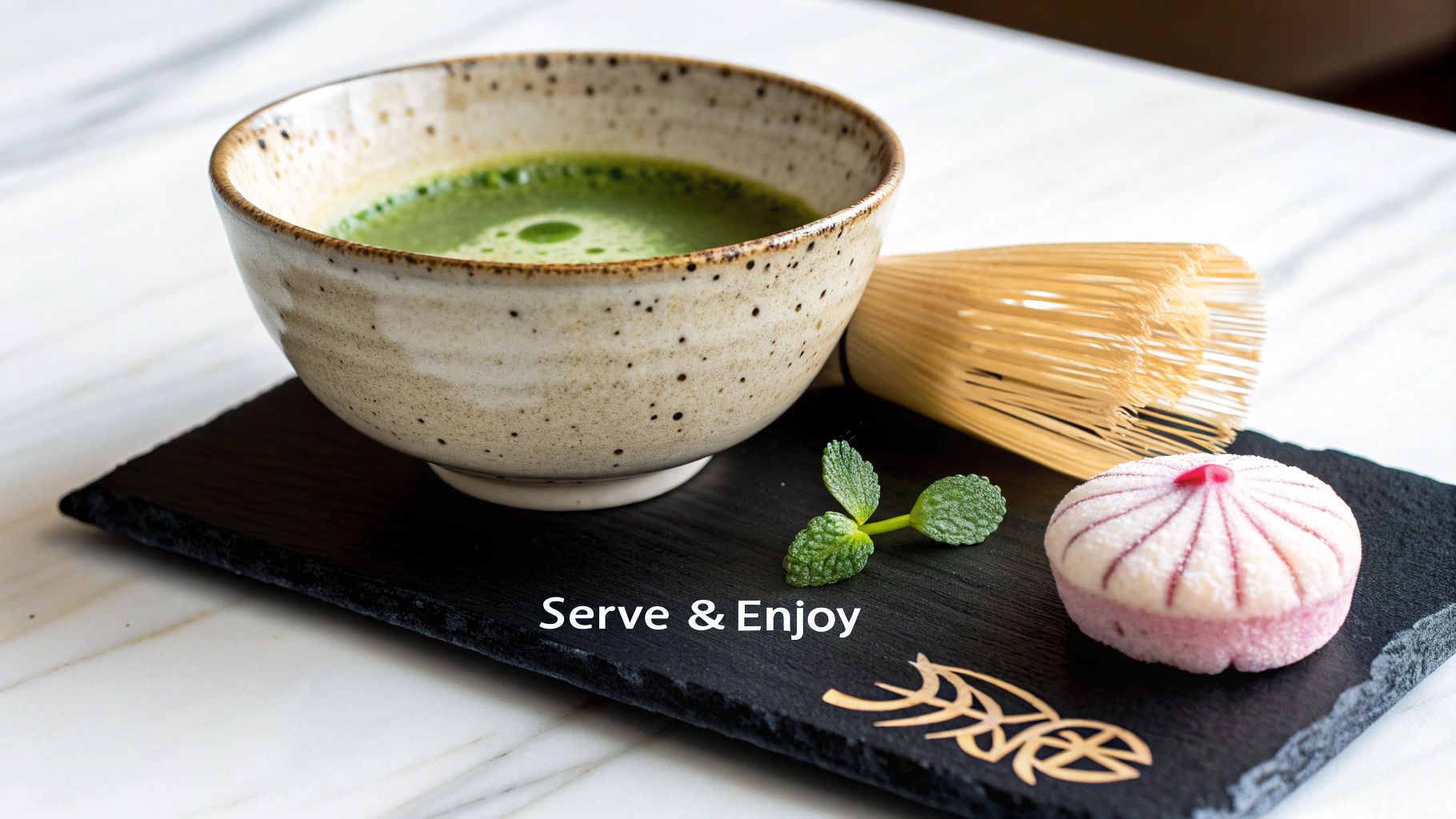
Learning how to prepare matcha is one side of the coin, but it all starts with exceptional powder. The quality of your matcha is everything—it dictates the colour, texture, and ultimately, the flavour in your cup.
A truly great ceremonial grade matcha, like our Amatsu Pure, is unmistakable. It boasts a stunning, vibrant green colour and a fine, silky texture. When you whisk it, you get that deep, complex umami flavour that lower-grade powders just can't replicate. They often end up tasting bitter or flat.
It's also worth knowing that market conditions can play a big part. Recent extreme weather in Japan’s main tea-growing regions has caused a significant matcha shortage, which has had a knock-on effect on availability and pricing here in the UK. This makes finding a source you can rely on more crucial than ever.
Choosing a brand that prioritises high-quality sourcing is your best guarantee for a consistent and superior tea experience. It ensures you’re not just drinking green tea, but enjoying matcha as it’s meant to be.
This is exactly why we're so committed to sourcing only the finest leaves for all our blends, from Pure to Strength. By understanding what sets premium matcha apart, you can make smarter choices and truly appreciate what makes it so special. For a deeper dive, our article on Pure Matcha vs green tea is a great place to start.
Your Matcha Questions, Answered
Even with a step-by-step guide, you're bound to have questions as you get into the rhythm of making matcha. It's all part of the learning process! Below, we've answered some of the most common queries, sharing practical tips to help you master the art of the perfect bowl.
Why Does My Matcha Taste Bitter?
This is the number one question we get, and the answer is almost always the same: your water is too hot.
Anything over 80°C (175°F) will literally scorch the delicate tea leaves, releasing a harsh, bitter flavour. The fix is simple. Once your kettle boils, just let it sit for a few minutes to cool down before you pour.
The quality of your powder can also play a role. If you're using a lower-grade matcha, it might have an inherently more bitter taste. Starting with a high-quality ceremonial grade, like Amatsu Pure, sets you up for a naturally sweet and velvety smooth experience right from the get-go.
Can I Make Matcha Without a Bamboo Whisk?
Absolutely. While the traditional bamboo whisk, or chasen, is designed specifically to create that beautiful, stable foam, you're not stuck if you don't have one.
A small, handheld electric milk frother is a brilliant substitute and probably your best bet. It does a fantastic job of whipping air into the tea. If you're really in a bind, you can even add the matcha and water to a small jar, seal it tightly, and shake it like you mean it.
Just a heads-up: these methods might not dissolve every single tiny clump the way a chasen does. The 100-plus prongs of a traditional whisk are unmatched for creating that perfectly smooth suspension.
How Much Matcha Powder Do I Actually Need?
For a standard, everyday bowl of matcha, you'll want to use 1-2 grams of powder. That works out to be about half a teaspoon or one to two scoops with a traditional bamboo chashaku.
This amount is perfect for making usucha (thin tea), which is typically mixed with 60-80ml (2-3 oz) of water. For our functional blends like Amatsu Radiance or Strength, one serving is all you need to get the full benefits.
If you're feeling adventurous and want to try koicha (thick tea), a much more intense and syrupy preparation, you can double the amount of Amatsu Pure to 4 grams. Our advice? Start with the standard serving and adjust until you find the strength that makes you happy. Nailing these fundamentals is just as important as understanding why Londoners are ditching coffee for matcha.
Ready to turn your daily cup into a ritual you'll love? Find a matcha that's consistently smooth, vibrant, and bursting with flavour. Explore the Amatsu Matcha collection and discover the perfect partner for your wellness journey.
Read more
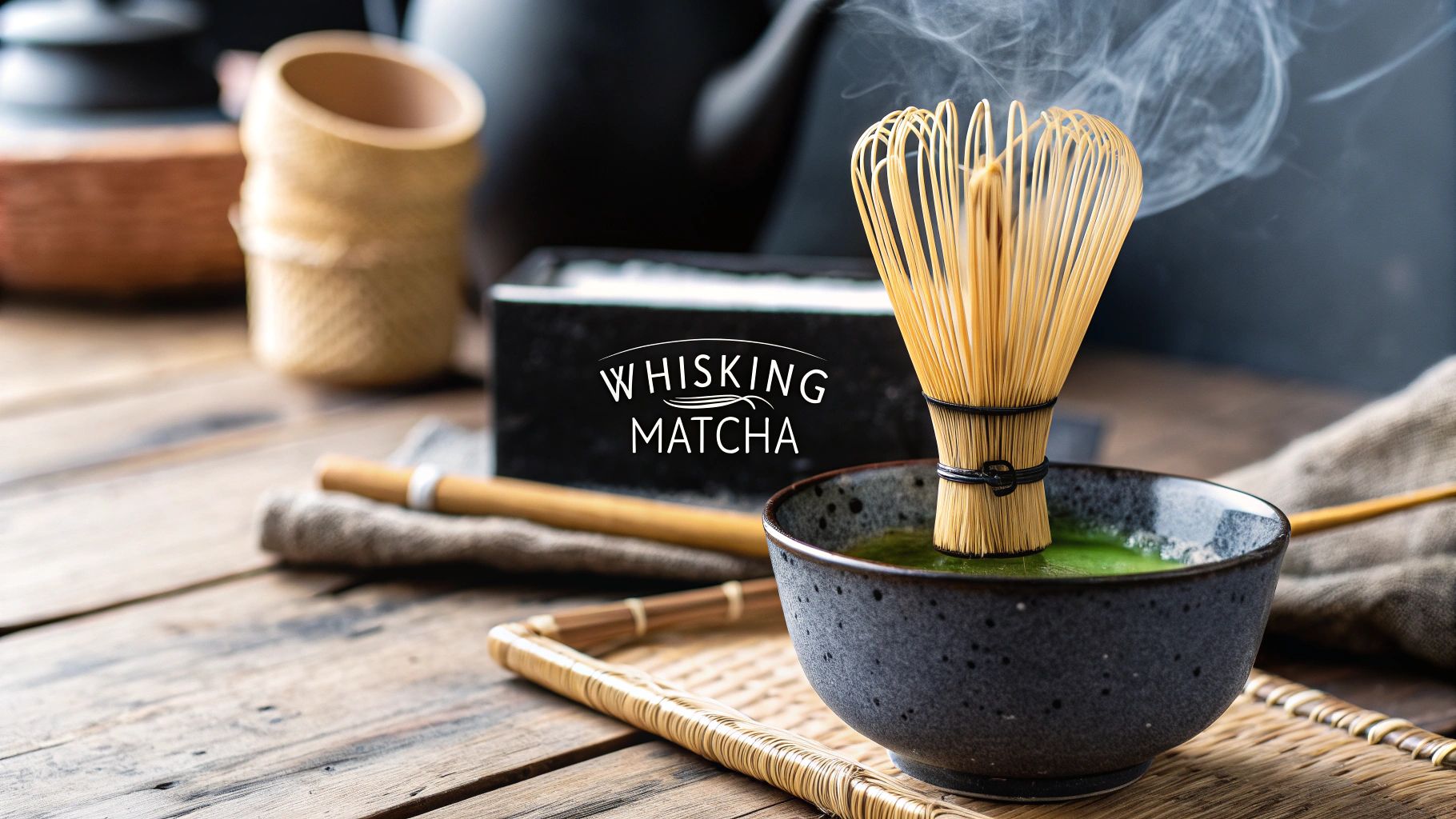
Learn how to whisk matcha like a pro. Our guide covers the tools, techniques, and tips to create a smooth, frothy, and delicious cup every single time.
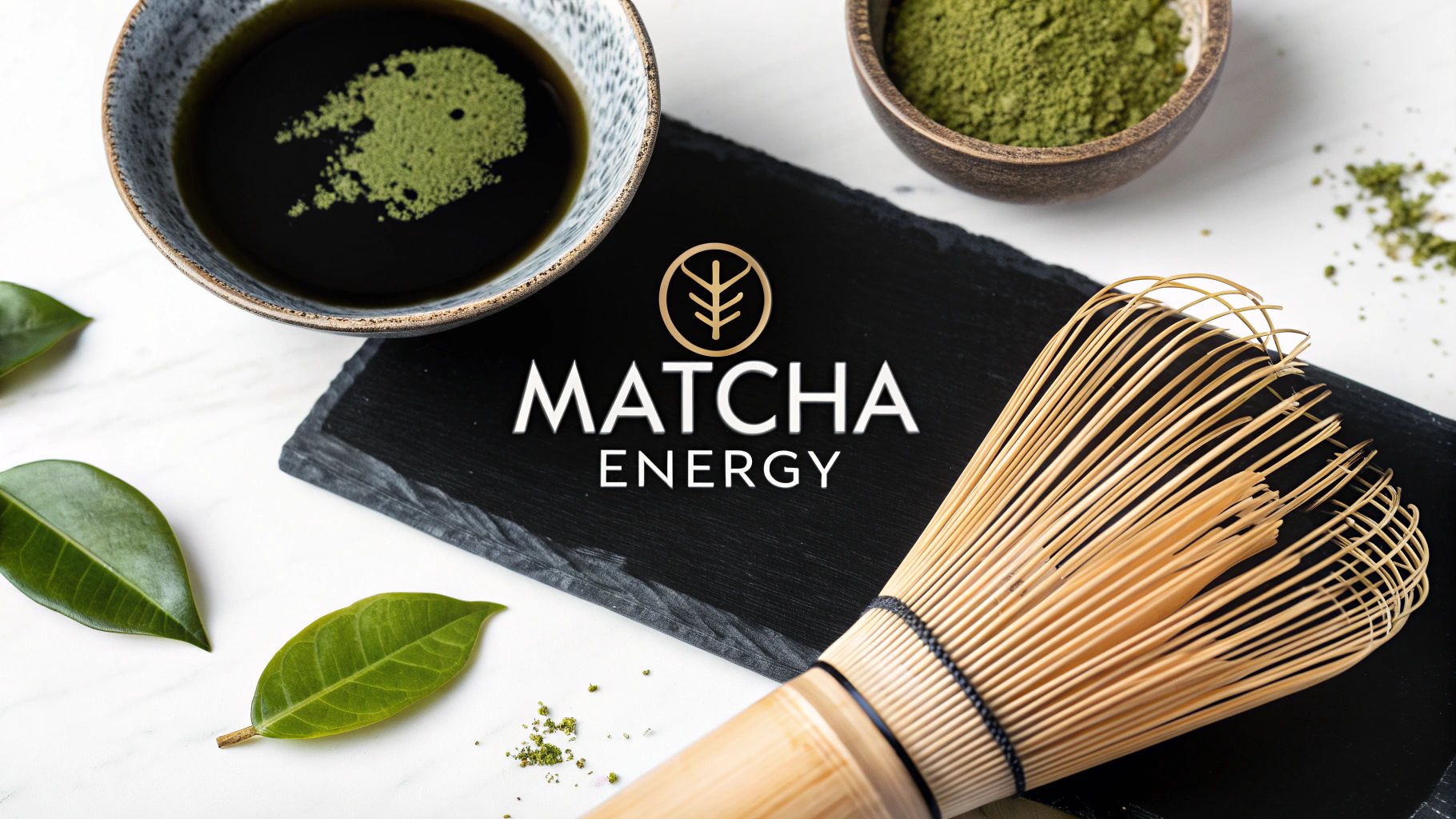
Looking for a natural boost? Discover how matcha for energy offers a clean, sustained lift. Find the best matcha to energize your routine!
